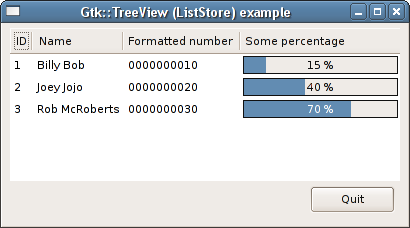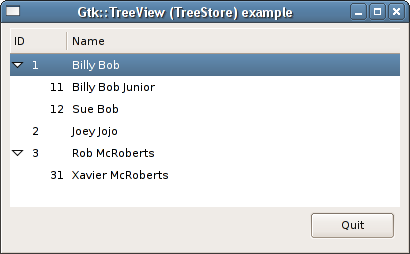Modellen
Each Gtk::TreeView has an associated Gtk::TreeModel, which contains the data displayed by the TreeView. Each Gtk::TreeModel can be used by more than one Gtk::TreeView. For instance, this allows the same underlying data to be displayed and edited in 2 different ways at the same time. Or the 2 Views might display different columns from the same Model data, in the same way that 2 SQL queries (or "views") might show different fields from the same database table.
Although you can theoretically implement your own Model, you will normally use either the ListStore or TreeStore model classes.
ListStore, för rader
ListStore innehåller enkla rader med data, och varje rad saknar underordnade.
TreeStore, för en hierarki
TreeStore innehåller rader med data, och varje rad kan ha underordnade rader.
Modellkolumner
The TreeModelColumnRecord class is used to keep track of the columns and their data types. You add TreeModelColumn instances to the ColumnRecord and then use those TreeModelColumns when getting and setting the data in model rows. You will probably find it convenient to derive a new TreeModelColumnRecord which has your TreeModelColumn instances as member data.
class ModelColumns : public Gtk::TreeModelColumnRecord
{
public:
ModelColumns()
{ add(m_col_text); add(m_col_number); }
Gtk::TreeModelColumn<Glib::ustring> m_col_text;
Gtk::TreeModelColumn<int> m_col_number;
};
ModelColumns m_Columns;You specify the ColumnRecord when creating the Model, like so:
Glib::RefPtr<Gtk::ListStore> refListStore =
Gtk::ListStore::create(m_Columns);As a TreeModelColumnRecord describes structure, not data, it can be shared among multiple models, and this is preferable for efficiency. However, the instance (such as m_Columns here) should usually not be static, because it often needs to be instantiated after glibmm has been initialized. The best solution is to make it a lazily instantiated singleton, so that it will be constructed on-demand, whenever the first model accesses it.
Lägga till rader
Lägg till rader till modellen med metoderna append(), prepend() eller insert().
auto iter = m_refListStore->append();You can dereference the iterator to get the Row:
auto row = *iter;Lägga till underordnade rader
Gtk::TreeStore-modeller kan ha underordnade objekt. Lägg till dem med metoderna append(), prepend() eller insert(), så här:
auto iter_child =
m_refTreeStore->append(row.children());Ställa in värden
You can use the operator[] overload to set the data for a particular column in the row, specifying the TreeModelColumn used to create the model.
row[m_Columns.m_col_text] = "litetext";Hämta värden
You can use the operator[] overload to get the data in a particular column in a row, specifying the TreeModelColumn used to create the model.
auto strText = row[m_Columns.m_col_text];
auto number = row[m_Columns.m_col_number];Kompilatorn kommer klaga om du använder en olämplig typ. Exempelvis skulle detta generera ett kompileringsfel:
//kompileringsfel - ingen konvertering från ustring till int.
int number = row[m_Columns.m_col_text];
